Ronald Araújo scored a 93rd-minute winner for Barcelona in their La Liga clash with Catalan rivals Girona on Saturday as Hansi Flick’s side moved to the top of the table.
La Blaugrana raced out of the blocks as they sought redemption from…

Ronald Araújo scored a 93rd-minute winner for Barcelona in their La Liga clash with Catalan rivals Girona on Saturday as Hansi Flick’s side moved to the top of the table.
La Blaugrana raced out of the blocks as they sought redemption from…

In the clubs’ first meeting since Bath won a closely fought Twickenham showpiece in June, it was the away side who struck first.
Santi Carreras, in his first Bath start, kicked forward in midfield for his team-mates to chase. The ball was spilled…
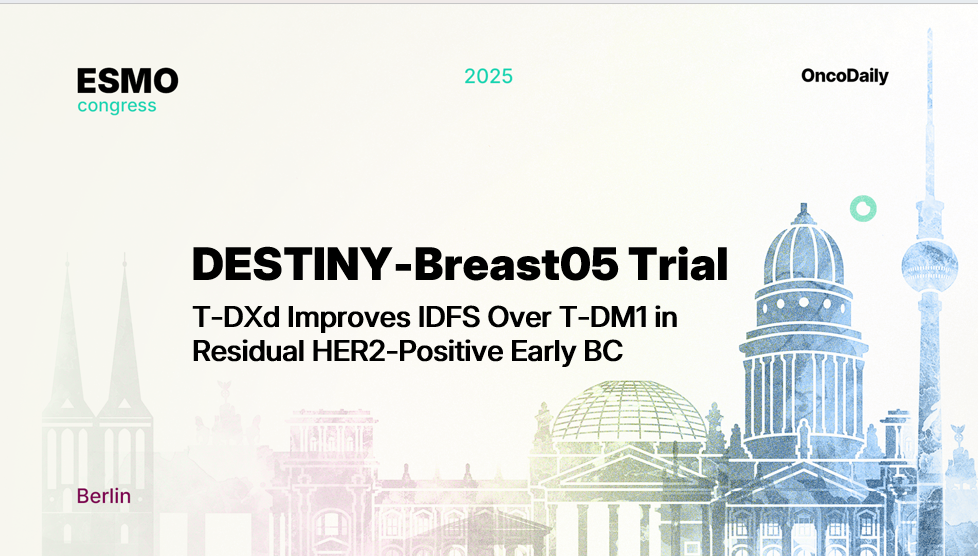
DESTINY-Breast05 (NCT04622319), presented by Dr. Charles E. Geyer (Pittsburgh, United States of America) at the ESMO Congress 2025, is a pivotal phase 3, open-label, randomized trial evaluating trastuzumab deruxtecan (T-DXd) versus the standard-of-care trastuzumab emtansine (T-DM1) in patients with HER2-positive early breast cancer (eBC) who had residual invasive disease after neoadjuvant therapy. The study was designed to determine whether T-DXd could improve long-term outcomes for this high-risk population compared with T-DM1, the established post-neoadjuvant standard of care
Patients with HER2-positive early breast cancer who have residual invasive disease following neoadjuvant chemotherapy and anti-HER2 therapy face a high risk of recurrence, particularly distant relapse. T-DM1 became the standard post-neoadjuvant treatment following the KATHERINE trial, but outcomes remain suboptimal for patients with high residual disease burden. Trastuzumab deruxtecan (T-DXd), a next-generation HER2-directed antibody–drug conjugate with a potent topoisomerase I inhibitor payload, has shown marked efficacy in metastatic settings, prompting investigation into its use in the early disease setting to reduce recurrence risk.
In DESTINY-Breast05, 1,635 patients with HER2-positive eBC and residual invasive disease after neoadjuvant taxane-based chemotherapy and HER2-targeted therapy were randomized 1:1 to receive either:
Eligible patients were considered high risk for recurrence, defined by clinical stages T4, N0–3, M0 or T1–3, N2–3, M0 at presentation, or residual nodal disease after neoadjuvant therapy.
The primary endpoint was invasive disease-free survival (IDFS), with disease-free survival (DFS) as a key secondary endpoint. Additional endpoints included overall survival (OS), distant recurrence-free interval, brain metastasis–free interval (BMFI), and safety.
At the data cutoff of July 2, 2025, median follow-up was 29.9 months in the T-DXd arm and 29.7 months in the T-DM1 arm.
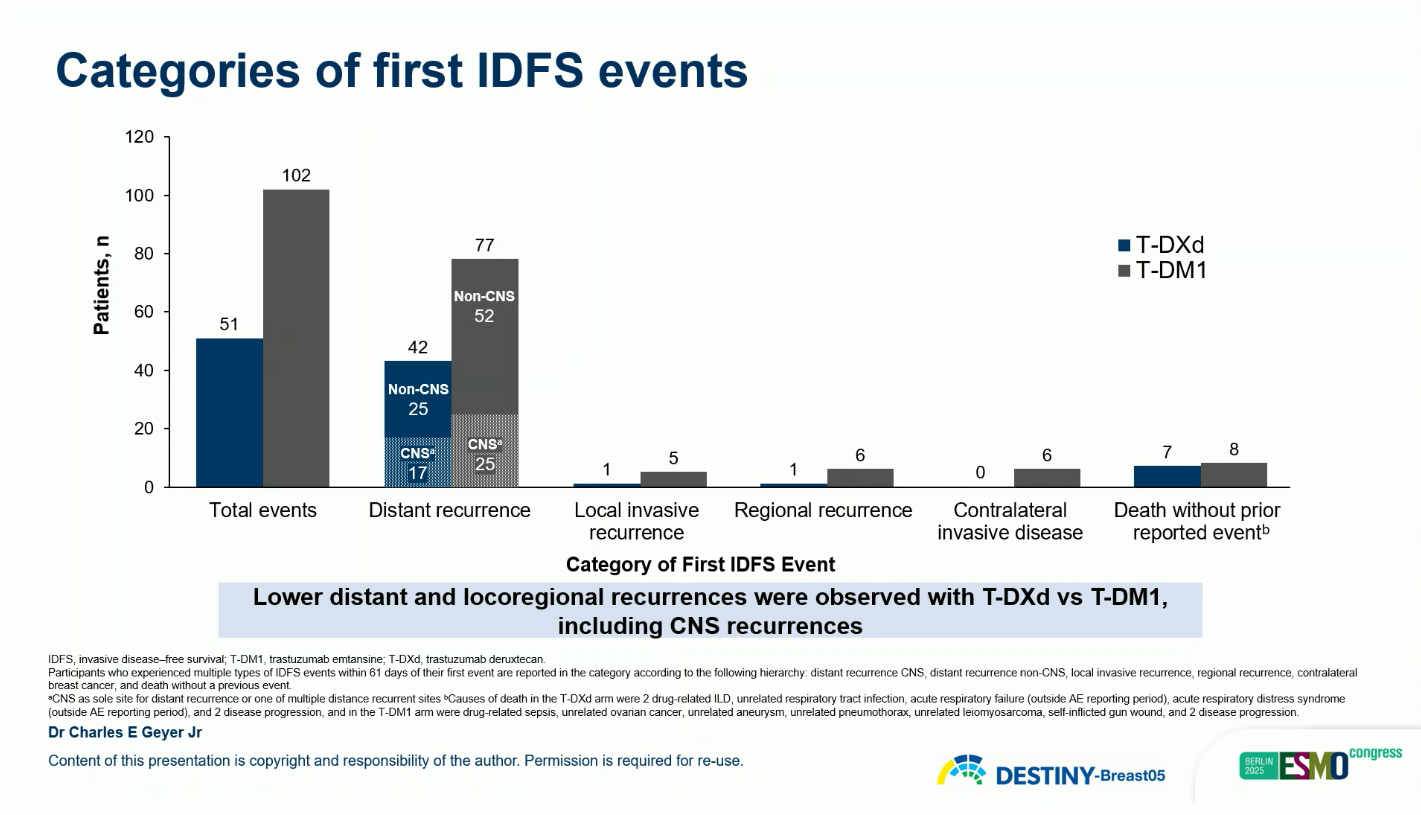
Similarly, the key secondary endpoint of disease-free survival (DFS) demonstrated a parallel benefit, with a hazard ratio of 0.47 (95% CI, 0.34–0.66; p < 0.0001). The 3-year DFS rate was 92.3% with T-DXd compared with 83.5% with T-DM1, corresponding to an 8.8% absolute gain.
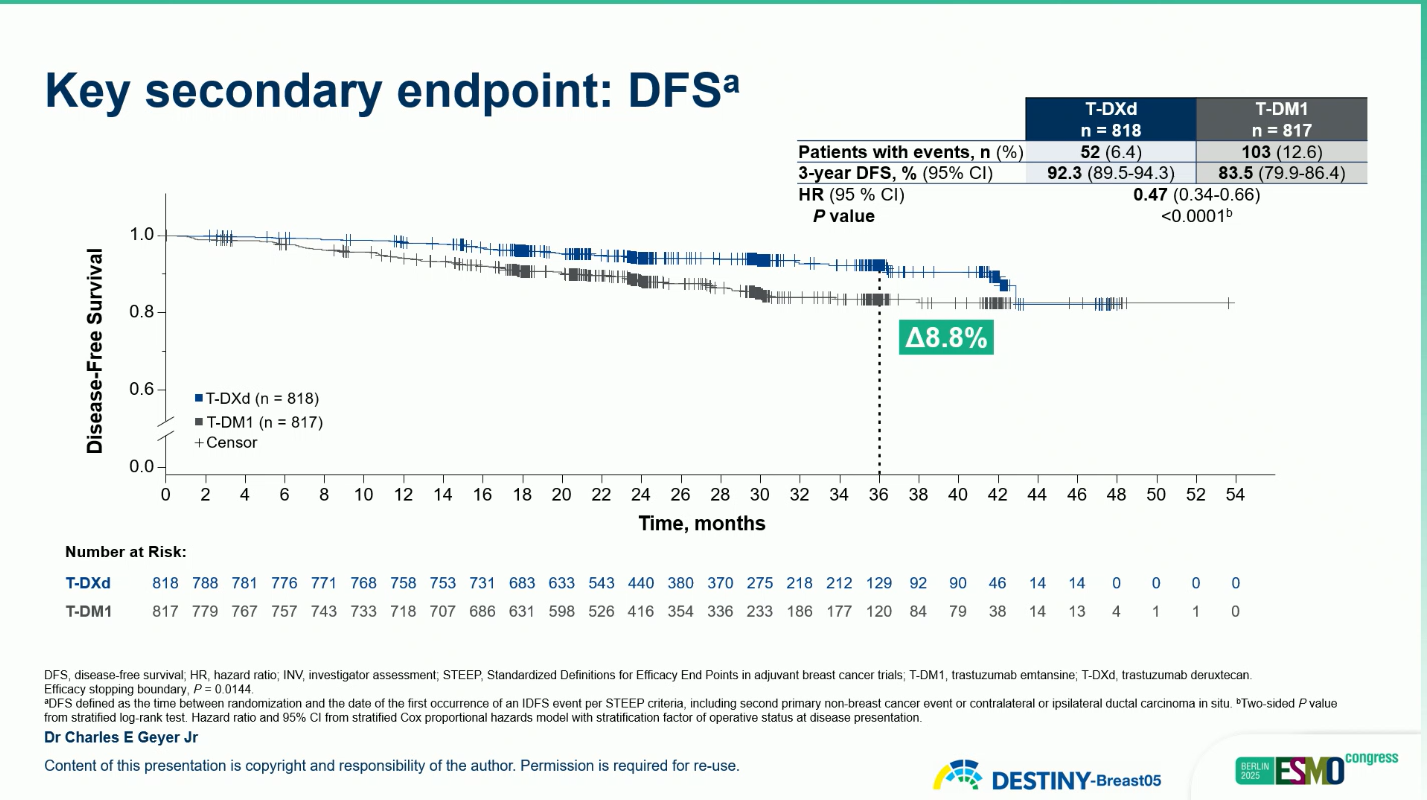
These findings represent a 53% reduction in risk of invasive disease recurrence or death with T-DXd compared with T-DM1.
A clinically meaningful improvement in BMFI was also observed (HR 0.64; 95% CI 0.35–1.17), suggesting enhanced control of central nervous system relapse.
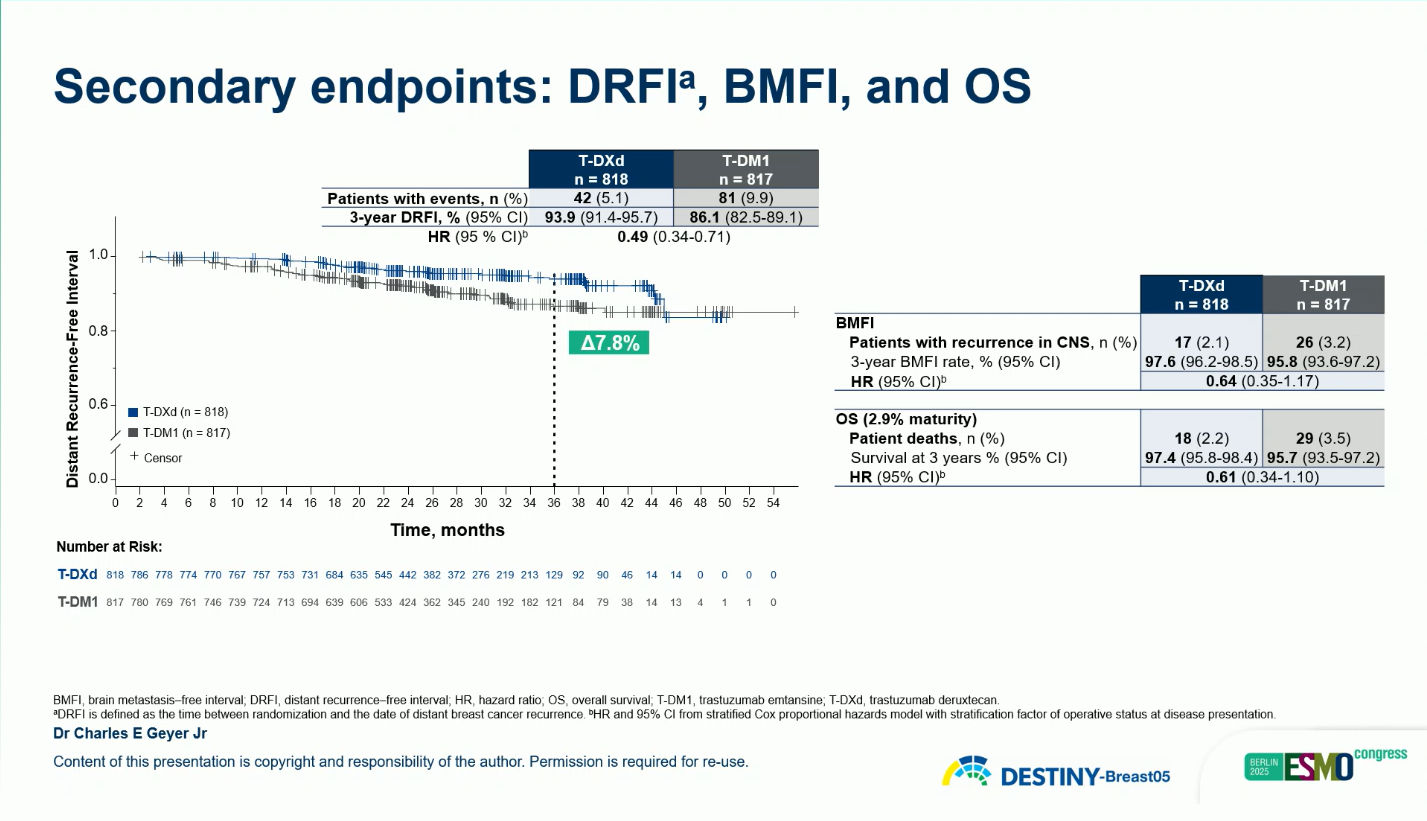
The overall safety profile of T-DXd was manageable and consistent with prior studies.
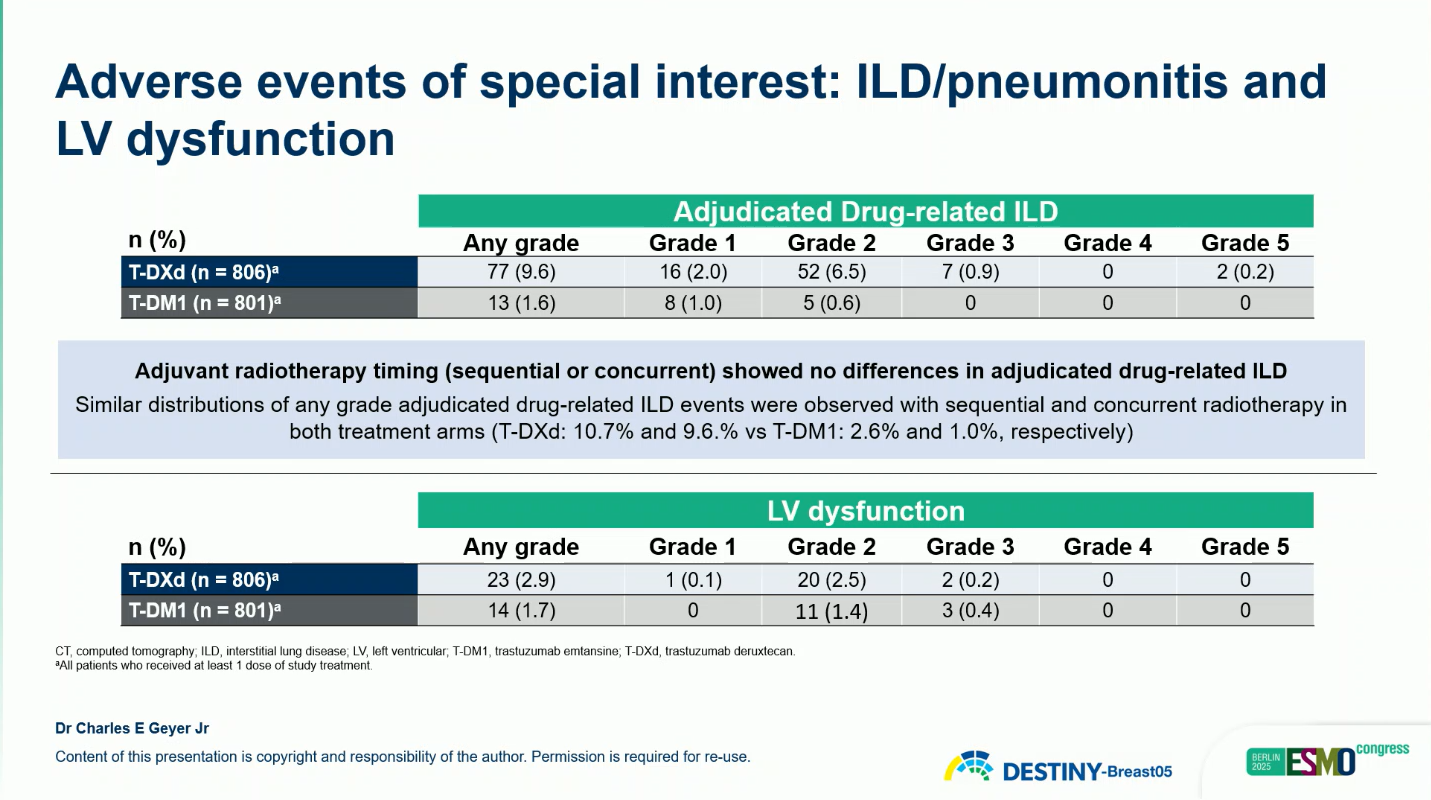
Most ILD events were grade 1–2 and resolved with treatment modification or corticosteroids. No new safety signals were identified.
The DESTINY-Breast05 trial demonstrated that trastuzumab deruxtecan (T-DXd) offers a statistically significant and clinically meaningful improvement in both invasive disease-free survival (IDFS) and disease-free survival (DFS) compared with trastuzumab emtansine (T-DM1) in patients with HER2-positive early breast cancer who had residual invasive disease following neoadjuvant therapy.
These findings mark a pivotal advance in the post-neoadjuvant management of HER2-positive breast cancer. By extending the proven efficacy of T-DXd beyond the metastatic setting into early-stage, high-risk disease, the results highlight its potential to redefine the standard of care for patients who previously had limited options after incomplete response to neoadjuvant therapy. Importantly, the benefit was consistent across all major subgroups, including hormone receptor–positive and –negative disease, as well as across regions and baseline disease characteristics, underscoring the robustness of the findings.
You can read the full abstract here.
This request seems a bit unusual, so we need to confirm that you’re human. Please press and hold the button until it turns completely green. Thank you for your cooperation!

Google has unveiled Veo 3.1, the latest version of its AI video generation model, featuring improved audio output, advanced editing tools, and enhanced image-to-video performance. Building on May’s Veo 3 release, the update delivers more…

Watch a room of 70-somethings when “Mrs. Robinson” starts. Shoulders straighten, eyes soften, lips move to words unvisited for decades. For three minutes and thirty seconds, mortgages and medications vanish. They’re nineteen again,…

San Diego, CA. October 17, 2025. Posing for the AI Camera at Twitch Con.
Charlie Fink
At TwitchCon San Diego, the Israeli startup Decart staged a live demonstration of something I’ve not seen before: real-time generative AI video. Partnering…